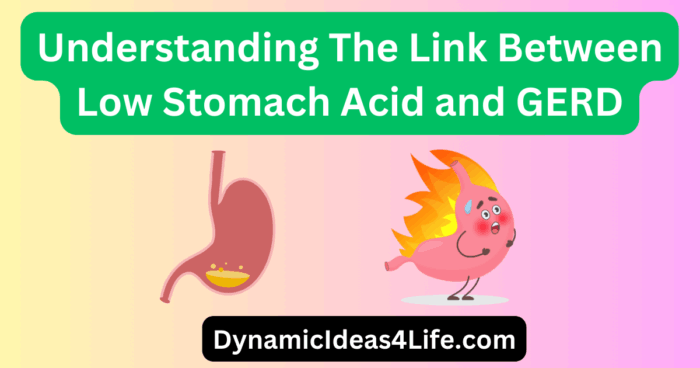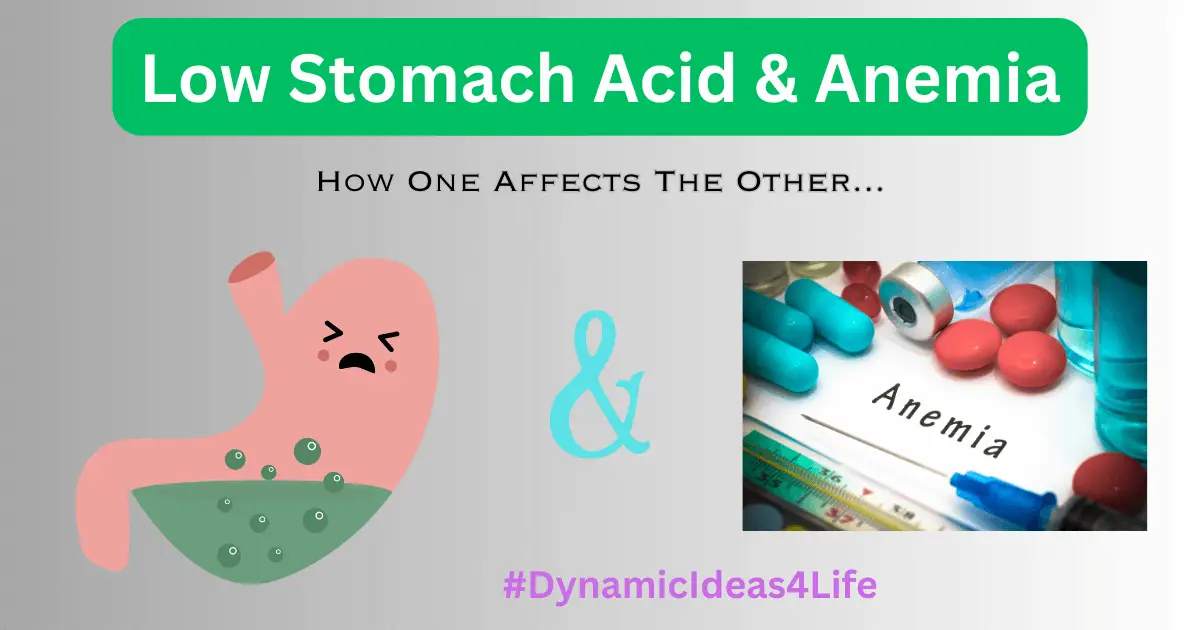With growing concerns over our daily health habits, understanding the implications of different medical conditions has become pivotal. The correlation between Low Stomach Acid and Anaemia, two seemingly unrelated conditions, is a great example of this and this is something we will look to explore in today’s article.
Unveiling this correlation, symptoms, causes, and effects, and discussing how both Low Stomach Acid and Anemia can be managed and prevented may be the first line of defence for many individuals.
This knowledge could ultimately contribute to the better management of health, improving the quality of life and longevity in the process. So let’s take a look at this…
Understanding Low Stomach Acid and Anaemia
So Low Stomach Acid, also known as Hypochlorhydria, is a condition where the production of hydrochloric acid in the stomach is insufficient. Hydrochloric acid (HCL) plays a crucial role in digestion by breaking down food particles and activating enzymes that further digest these particles.
It also assists in absorbing important nutrients such as vitamin B12, iron, and calcium.
Calcium and B Vitamins alongside other vitamins and minerals are essential for good health and the body must absorb adequate amounts. But in particular not absorbing Iron or Vitamin B12 (AMIN) is what effectively causes Anemia.
Anemia = Iron Deficiency.
Now…
Symptoms of Low Stomach Acid
Low stomach acid often goes unnoticed since its general symptoms in many cases mimic those of excessive stomach acid (hyperchlorhydria). These symptoms may include;
- Heartburn,
- Belching or Burping,
- Bloating following a meal,
- a sense of fullness after eating only a small amount of food,
- Indigestion or discomfort,
- and Nausea.
In extreme cases, this condition can also lead to diarrhoea, malnutrition causing hair loss, brittle nails and weak bones, undigested food in stools, weakness, and fatigue.
Causes of Low Stomach Acid
Various factors can contribute to the development of low stomach acid. Age is one primary factor, as stomach acid production tends to decrease with advancing age. Stress, a poor diet, excessive use of antacids, and medication can also decrease stomach acid production.
Medical conditions like Helicobacter pylori infection, atrophic gastritis, or an autoimmune disorder may result in hypochlorhydria.
Diagnosis of Low Stomach Acid
Diagnosis of this condition is often challenging, as its symptoms are similar to other gastrointestinal conditions. A gastroenterologist may base their diagnosis on the patient’s medical history, physical examination, and symptoms.
Further diagnostic tests including a stomach acid test or a Heidelberg test can be carried out for confirmation.
The Common Link Between Low Stomach Acid and Anemia
Low stomach acid can affect the absorption of essential nutrients, such as Iron and vitamin B12, leading to deficiencies. Iron-Deficiency Anemia and Vitamin B12 Deficiency Anemia are common in people with low stomach acid. This deficiency could lead to haemoglobin reduction, the primary transporter of oxygen in the blood, resulting in symptoms like fatigue, weakness, pallor, and shortness of breath.
Iron absorption is an acid-dependent process. The acidic environment in the stomach converts dietary iron to a soluble state facilitating its absorption. So, with low stomach acid, iron uptake is limited leading to deficiency over time.
Likewise, stomach acid aids in separating vitamin B12 from dietary proteins for absorption. Thus, hypochlorhydria can affect B12 absorption, resulting in B12 deficiency anaemia.
Treating Low Stomach Acid (Hypochlorhydria)
Medical treatment for low stomach acid often involves addressing the underlying cause. If it’s an H.pylori infection that is the cause, for example, antibiotics can be prescribed. A healthcare provider might also recommend diet modifications that involve foods that naturally increase stomach acid.
Some examples include; apple cider vinegar, beets, and lemons. Typically healthcare professionals may also recommend avoiding foods that are known to trigger acid reflux. They too may If the case is severe suggest solutions to improve digestive health such as digestive enzymes, probiotics, and HCL supplements.
Low stomach acid can have a serious impact on both digestive health and overall well-being. If you’re experiencing symptoms linked to this condition, it’s important to consult with a healthcare professional as soon as possible. Immediate treatment can enhance the quality of life and prevent potential complications, such as anemia caused by deficits in essential nutrients.
Anaemia and its Connection to Low Stomach Acid
Exploring Anaemia
Anaemia is a medical condition identified by a shortage of healthy red blood cells. These cells play a vital role in transporting oxygen to tissues throughout the body, so when their numbers are depleted, it often results in fatigue and additional symptoms related to oxygen deprivation.
People living with anaemia may present a range of symptoms, and their nature and severity are often dependent on the root cause of the condition. Common signs include tiredness, shortness of breath, feeling lightheaded, irregular heartbeats, pain in the chest, dizziness, hands or feet feeling cold, skin appearing pale or yellowish, and recurring headaches.
The root causes of anaemia tend to fall into three main categories: loss of blood, low production of red blood cells, and excessive destruction of red blood cells.
Additional contributing factors can be a poorly balanced diet, unhealthy lifestyle choices, certain inherited genetic deficiencies, various chronic diseases, and infections.
Diagnosis of Anaemia
Anaemia is typically detected through a complete blood count (CBC) test. This test measures several variables concerning blood, including red blood cell count, haemoglobin, and haematocrit. A diagnosis can be confirmed if haemoglobin levels are low — generally under 13.5 gram/100 ml for men and 12.0 gram/100 ml for women.
Further diagnostic procedures might be necessary to identify the type and cause of anaemia, including additional blood tests, stool tests, endoscopy, or bone marrow biopsy.
Low Stomach Acid and Anaemia
A vital aspect of anaemia is its link with low stomach acid, also known as hypochlorhydria. Stomach acid, technically known as gastric acid, is crucial for the proper digestion of food, particularly protein. It readies the stomach for digestion and converts an enzyme called pepsinogen to pepsin, which breaks down protein and supplies the body with essential nutrients such as vitamin B12, iron, and calcium.
With low stomach acid levels, the body cannot efficiently break down food into the necessary nutrients that fuel the body and help produce red blood cells. This lack of nutrients can lead to malnourishment and anaemia.
Iron-Deficiency Anaemia and Low Stomach Acid
One of the more prevalent types of anaemia caused by low stomach acid is iron-deficiency anaemia. Iron is critical for producing haemoglobin, a protein in red blood cells that transports oxygen. Low stomach acid can hinder the body’s ability to absorb iron from food, leading to an iron-deficient state.
Understanding Pernicious Anaemia and Low Stomach Acid
Pernicious anaemia is an anaemia variant, associated with low stomach acid. This particular type of anaemia surfaces when your stomach is unable to produce adequate intrinsic factor – a protein that is essential for absorbing Vitamin B12.
It’s important to note that Vitamin B12 plays a significant role in red blood cell formation. Therefore, a deficiency of this vitamin could potentially result in a decrease in the red blood cell count, triggering anaemia.
Aside from this, low stomach acid may lead to various digestive complications like bloating, belching, and discomfort. This condition might also result in inadequate nutrient absorption, further contributing to a host of health issues, anaemia being one of them.
Therefore, to avoid such circumstances, maintaining a regular check on your stomach acid levels and obtaining suitable treatment for low stomach acid becomes imperative. Diagnosis can typically be made through procedures such as gastroscopy, pH testing, or a Heidelberg test.
Treatments often revolve around addressing the root causes, providing nutritional supplements, and in certain scenarios, prescribing medication or performing surgery.
Effects of Low Stomach Acid and Anaemia on General Health
Identifying the Underlying Causes of Low Stomach Acid
The condition of low stomach acid, medically referred to as hypochlorhydria, can arise from various factors such as stress, an unhealthy diet, ageing, or certain medications.
It’s important to bear in mind that this particular condition can have profound effects on the body’s capability to efficiently break down and absorb nutrients from the food we consume. This can potentially give rise to a series of health problems.
Symptoms Indicating Low Stomach Acid
Some of the typical symptoms of low stomach acid include bloating, belching, heartburn, feeling full quickly, and chronic constipation or diarrhoea. These symptoms may be mistaken for high stomach acid due to their similarity, but they often reflect an insufficient degree of acid.
Link between Low Stomach Acid and Anaemia
Anaemia is a condition in which the blood lacks enough healthy red blood cells to carry adequate oxygen to the body’s tissues. The inadequacy of stomach acid can lead to anaemia due to insufficient absorption of vital nutrients such as iron and Vitamin B12.
With low stomach acid, the body is unable to efficiently break down and absorb these nutrients leading to deficiencies. Iron deficiency anaemia and Vitamin B12 deficiency anaemia, also known as Pernicious anaemia, are two types that can arise from this scenario.
Symptoms of Anaemia
Anaemia often presents with fatigue, weakness, pale or yellowish skin, irregular heartbeats, shortness of breath, dizziness or lightheadedness, chest pain, cold hands or feet, and headaches.
These relate to the body’s struggle to supply sufficient oxygen to cells and tissues throughout the body due to the low count of red blood cells.
Risks and Complications Associated with Low Stomach Acid and Anaemia
Both low stomach acid and anaemia, especially when chronic, can wreak havoc on daily life. Fatigue, breathlessness, paleness, and general weakness can greatly reduce a person’s quality of life and daily functioning. With severe or long-standing anaemia, the risk of complications increases, potentially resulting in damaging effects on critical organs such as the heart or brain due to lack of oxygen-rich blood.
Further, low stomach acid also brings its set of complications. It can pave the way to digestive problems like gastric ulcers, due to gut bacteria’s unchecked growth. In general, the altered digestive process may lead to nutrient imbalances which can impact overall health.
Long-term implications of both these conditions also increase the risk of developing other prominent health issues, including other types of anaemias, heart conditions, nerve damage, digestive issues, and more.
Addressing Low Stomach Acid and Anaemia
When dealing with health problems such as low stomach acid or anaemia, it is critical to get medical help quickly. The cornerstone of effective management is a precise diagnosis. If anaemia is diagnosed, treatment could comprise dietary adaptations, supplementation, or medical prescriptions based on its particular type.
In the case of low stomach acid, healthcare experts might propose altering your diet and managing stress more effectively.
Additionally, supplementation or medical treatment could be a part of your regimen.
Beneficial therapies such as physical exercises could be suggested to help alleviate symptoms and contribute to overall health and well-being.
>>>Realted Post: Best Foods To Treat Anemia – Dietary Tips To Try At Home<<
Management and Treatment Options
Unpacking Low Stomach Acid and Anaemia
Low stomach acid or hypochlorhydria refers to a condition where your stomach’s ability to produce hydrochloric acid declines. This acid plays a crucial role in the digestion of proteins and in obtaining necessary nutrients like calcium, magnesium, and vitamin B12 from your food.
Anaemia, on the other hand, is a blood disorder characterised by a decline in either the number of circulating red blood cells, haemoglobin levels or both. This leads to the blood’s decreased capability to transport oxygen to the tissues of our body and can manifest symptoms such as fatigue, weakness, pallor, and irregular heartbeat.
The occurrence of these two conditions often overlaps since low stomach acid can lead to a deficiency in essential nutrients like Vitamin B12 and iron, both of which are critical for red blood cell production.
Medicinal Treatment Approach
Low stomach acid and anaemia are both treatable with medicinal intervention.
Anaemia treatment varies depending on the cause. Iron-deficiency anaemia, the most common type, is usually dealt with by iron supplements. For vitamin-deficiency anaemias, supplements of vitamin B12 or folic acid are commonly used. Severe types of anaemia may require blood transfusions, medications, and sometimes surgery.
Low stomach acid is somewhat more complex to treat as the medical community continues to debate the balance of reducing acid reflux symptoms and maintaining digestion. Individuals with suspected hypochlorhydria are usually treated with proton pump inhibitors (PPIs) to reduce stomach acid production, betaine hydrochloride supplements to artificially boost acid levels or digestive enzymes to aid in food breakdown.
Lifestyle Modifications
Lifestyle modifications can complement medicinal treatments and may help to manage these conditions more effectively. To manage low stomach acid, it can help to reduce intake of problematic foods, such as those high in fat or sugar, and to eat smaller, more frequent meals.
For those diagnosed with iron deficiency anaemia, a diet plan rich in iron is usually recommended. Iron-rich foods include leafy green vegetables, red meat, and fortified cereals. Foods rich in vitamin C can assist with the absorption of iron, while foods with calcium or caffeine can hinder it. Regular mild exercise can also stimulate appetite and improve the body’s capacity to absorb nutrients.
The Importance of Regular Checkups
Regardless of the course of treatment, people with low stomach acid or anaemia should attend regular checkups with their healthcare provider to monitor their progress. Blood tests can be used to evaluate the effectiveness of anaemia treatments, while the impact of treatments for low stomach acid can be evaluated through discussion of symptom improvements.
Chronic vs Acute Considerations
Both low stomach acid and anaemia can be chronic or acute conditions. Chronic conditions persist over a long term, while acute conditions develop suddenly and may be severe. Chronic conditions may require long-term management plans, involving regular medication and a consistent diet. Acute conditions, on the other hand, may require immediate medical attention followed by short-term treatments.
Conclusions from Clinical Research
There is some clinical research suggesting that managing stomach acid levels can help to prevent anaemia. Studies have found a link between the regular use of antacids or PPIs and the onset of anaemia, likely because these drugs can affect the absorption of iron and vitamin B12. Therefore, strategies for managing low stomach acid should also take anaemia prevention into account.
Should you find yourself dealing with low stomach acid or anaemia, rest assured that with appropriate treatment and lifestyle modifications, a healthy and fulfilling life can indeed be led. Attaining an accurate diagnosis and treatment plan from a professional healthcare expert is an essential step towards this goal.
Prevention Strategies
Unravelling the Complexity of Anaemia and Low Stomach Acid
Both anaemia and low stomach acid, also referred to as Hypochlorhydria, are health conditions that warrant attention. Anaemia is a condition where the body lacks the necessary quantity of red blood cells or haemoglobin, the element in your red blood cells responsible for oxygen transport. This leads to a diminished capacity of the body’s tissues to receive oxygen; manifesting in symptoms such as dizziness, fatigue, and an increased sensitivity to cold. Conversely, Hypochlorhydria is characterised by an inadequate secretion of stomach acid, which plays a significant role in protein digestion, nutrient absorption, and keeping harmful bacteria in check. Any deficiency can potentially trigger allergies, diseases, and nutritional inadequacies.
Dietary Changes
Modifying your diet is one of the fundamental strategies to prevent the development of these conditions. A nutrient-rich diet can effectively keep anaemia at bay. Foods rich in iron, such as red meat, poultry, peas, and dried fruits can help in increasing the red blood cell count. Iron from plant sources are less easily absorbed by the body, but you can help your body absorb these irons better by eating these foods along with a source of vitamin C. Foods high in folic acid, such as leafy green vegetables, and vitamin B12, found in animal products like meat and dairy, are also beneficial.
For low stomach acid prevention, add foods high in zinc like oysters, organic poultry, spinach and pumpkin seeds as they help in producing stomach acid. Apple cider vinegar or lemon before meals stimulate stomach acid production. Avoid processed and fast foods, which can reduce the stomach’s capacity to produce acid.
Physical Activity
Physical activity can also influence the body’s blood cell production and overall digestive health. Regular moderate exercise can help stimulate the formation of red blood cells, thus preventing anaemia. At the same time, physical activity can help stimulate the digestive system, promoting the production of digestive enzymes including stomach acid.
Routine Health Checks
Keep up with routine health checks to monitor your levels of iron, folic acid, and vitamin B12 to prevent anaemia. Similarly, checking your stomach acid levels routinely can help detect any deviance timely. Early intervention can help prevent more serious issues down the line.
Other Prevention Strategies
Beyond diet and exercise, other lifestyle changes can also contribute to preventing such conditions. Avoid smoking and excessive alcohol use, which can lower your red blood cell count and deplete your body of key nutrients. Excessive use of antacids can also reduce the stomach acid production. If you are on medication, consult your doctor as some medications might affect the stomach acid levels or red blood cell count.
It’s also worth understanding that low stomach acid can be one of the causes of anaemia. A reduction in the stomach’s acidity weakens its ability to extract iron from food. This iron is necessary for the production of red blood cells, and without sufficient levels, anaemia can occur.
In summary, diet, exercise and regular health checks form the triad of prevention against low stomach acid and anaemia. Incorporating these habits into your daily routine can go a long way in maintaining your health.
In Conclusion
Indeed, understanding the complex relationship between low stomach acid and anaemia is integral to promoting optimal health management. Through the exploration of their causes, effects, treatment options, and preventive measures, we can equip ourselves with the necessary knowledge and tools to deal with these conditions.
It also becomes clear that investing in our health, through constant learning and adopting healthy lifestyle changes, can prevent or manage these conditions, ensuring a better quality of life. Making health a priority is not just about treatment, it’s about prevention too.
We hope this article has been helpful. If you’d like to learn more check out our posts about Low Stomach Acid (Hypochlorhydria) Here<<<




